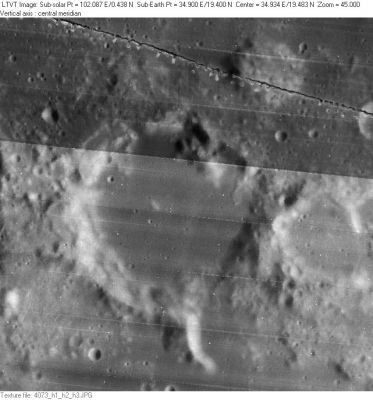Maraldi
Contents
Maraldi
| Lat: 19.4°N, Long: 34.9°E, Diam: 39 km, Depth: 2 km, Rükl: 25, Nectarian |
LO-IV-073H Maraldi is in the center. The button-like circle of hills to its northeast is Mons Maraldi. 18-km Maraldi F is just to the right of the main crater, and half of 8-km Maraldi A can be seen above it along the right margin.
Images
LPOD Photo Gallery Lunar Orbiter Images Apollo Images
Maps
(LAC zone 43D4) LAC map Geologic map LTO map
Description
Description: Elger
(IAU Directions) MARALDI.--A deep but rather inconspicuous formation, bounded on the E. by a polygonal border. A small ring-plain with a central mountain is connected with the S.E. wall; and, running in a N. direction from this, is a short mountain arm which joins a large circular enclosure with a low broken border standing on the N. side of the Mare Tranquillitatis.
Description: Wikipedia
Additional Information
Depth data from Kurt Fisher database
- Pike, 1976: 2 km
- Westfall, 2000: 1.5 km
- Viscardy, 1985: 1.3 km
- Cherrington, 1969: 1.31 km
Nomenclature
- This crater name honors two men:
- Giacomo Filippo Maraldi (August 21, 1665 – December 1, 1729) was an Italian-born French astronomer and mathematician, and a nephew of Giovanni Cassini. From 1700 until 1718 he worked on a catalog of fixed stars, and from 1672 until 1719 he studied Mars extensively. His most famous astronomical discovery was that the ice caps on Mars are not exactly on the rotational poles of that body. He also recognized that the corona visible during a solar eclipse belongs to the Sun not to the Moon.
- Giovanni Domenico Maraldi (April 17, 1709 - November 14, 1788), was an Italian-born French astronomer, nephew of Giacomo F. Maraldi. While observing Comet De Chéseaux with Jacques Cassini in 1746, he discovered two "nebulous stars", which later turned out to be globular clusters M15 and M2.
- According to Whitaker (p. 218), this name was introduced by Schröter. Whether it was meant to honor both men is unknown. If so, it would be one of the very few instances of multiple honorees in the original IAU nomenclature -- nearly all other names honoring a single person.
LPOD Articles
Bibliography
- APOLLO OVER THE MOON; A VIEW FROM ORBIT, Chapter 3: The Terrae (Part 2), Figures 50 and 52.
Maraldi and Miraldi
This is something to investigate, because some books show the name MIRALDI, such as Burnham's Celestial Handbook (page 437), or T.W.Webb's Celestial Objects for Common Telescopes, Volume 2 - The Stars (page 201).
- DannyCaes Aug 3, 2015
